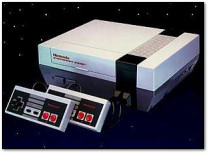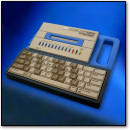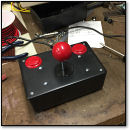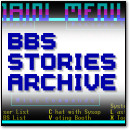 While strolling through my local World Market store last year, a familiar-looking candy tin caught my eye. Upon further inspection, I realized that it was shaped like a NES control pad. Trying to avoid another impulse purchase, I passed up the opportunity.
While strolling through my local World Market store last year, a familiar-looking candy tin caught my eye. Upon further inspection, I realized that it was shaped like a NES control pad. Trying to avoid another impulse purchase, I passed up the opportunity.
Fast forward to yesterday, when my wife comes home from shopping and announces that she has a present for me.
“Close your eyes, and put out your hand.”
I reluctantly comply.
“Now spin around three times.”
As I slow down, she places a cold, rattling metal box on my palm. I open my eyes. To my astonishment, I find a brand new tin of Nintendo Power mints floating in thin air — just above the floor, as I collapse.
It was particularly good gift, since I had co-incidentally been thinking about them recently because of my last “Game Boy Bubble Gum” Retro Scan. Some gifts are worth a bruise or two.
The Tin’s the Thing
 For $1.49 (US), you get about 84 white, pill-shaped mints in a stylish metal package. Unfortunately, I found the mints’ flavor to be somewhat lacking: unlike Altoids, these are “curiously weak” mints with a slightly unpleasant chalky consistency. But the tin alone is probably worth the price. Therein lies all the novelty, of course, and the real reason anyone would buy this product.
For $1.49 (US), you get about 84 white, pill-shaped mints in a stylish metal package. Unfortunately, I found the mints’ flavor to be somewhat lacking: unlike Altoids, these are “curiously weak” mints with a slightly unpleasant chalky consistency. But the tin alone is probably worth the price. Therein lies all the novelty, of course, and the real reason anyone would buy this product.
The tin’s two-part design of smooth, rounded aluminum closes firmly and is well-constructed. It’s about the same size as a real NES controller, which is particularly cool. The printed control-pad effect is significantly enhanced by the slightly embossed buttons and D-pad on the lid of the tin. And after you finish all your mints, you can store your Nintendo DS games and extra styluses in it. Or dead bugs — it’s your choice.
Why the manufacturer branded these mints with “Nintendo Power” (the official magazine of all things Nintendo) is unknown to me. It would have been much cooler if they referenced the Nintendo Entertainment System (in words) somewhere on the package. Barring that, they could have at least called it the “Mintendo Entertainment System.”
Now you’re eating with power. Minty power.
| The Skinny: Nintendo Power Mints |
| Good Features: |
Awesome NES control pad-shaped tin. Inexpensive. Very few calories. Useful for Nintendo DS game storage. |
| Bad Features: |
Mints have an authentic left-over-from-the-1980s chalky taste. They’re called “Nintendo Power” mints for some reason. |
VC Rating:
(10 Being Best) |
[ 7 out of 10 ] Shiny Marbles – Very Good |


 The PowerPak retains the familiar form factor of classic licensed NES cartridges, albeit rendered in a translucent orange plastic. Cut from top edge of each PowerPak is a notch through which a standard compact flash (CF) card may be conveniently inserted or removed. Turn on a NES with the PowerPak cart inside, and you’ll see an on-screen menu that lists all the games on the CF card. Pick one from the list, you’ll be playing the game as if you had the game’s original cartridge in the console.
The PowerPak retains the familiar form factor of classic licensed NES cartridges, albeit rendered in a translucent orange plastic. Cut from top edge of each PowerPak is a notch through which a standard compact flash (CF) card may be conveniently inserted or removed. Turn on a NES with the PowerPak cart inside, and you’ll see an on-screen menu that lists all the games on the CF card. Pick one from the list, you’ll be playing the game as if you had the game’s original cartridge in the console.

 Even among collectors, manual TV/GAME switches are mostly useless these days because most of us try to make at least composite (or better) video connections to our TVs, either via special cables or modifications to the systems themselves. Still, if you want to play classic machines like the Atari VCS without video hacks, you’ll probably need to use one.
Even among collectors, manual TV/GAME switches are mostly useless these days because most of us try to make at least composite (or better) video connections to our TVs, either via special cables or modifications to the systems themselves. Still, if you want to play classic machines like the Atari VCS without video hacks, you’ll probably need to use one.



 [ “Ask RedWolf” is a regular column where Benj Edwards (aka RedWolf) answers readers’ questions about computers and video games. ]
[ “Ask RedWolf” is a regular column where Benj Edwards (aka RedWolf) answers readers’ questions about computers and video games. ]





